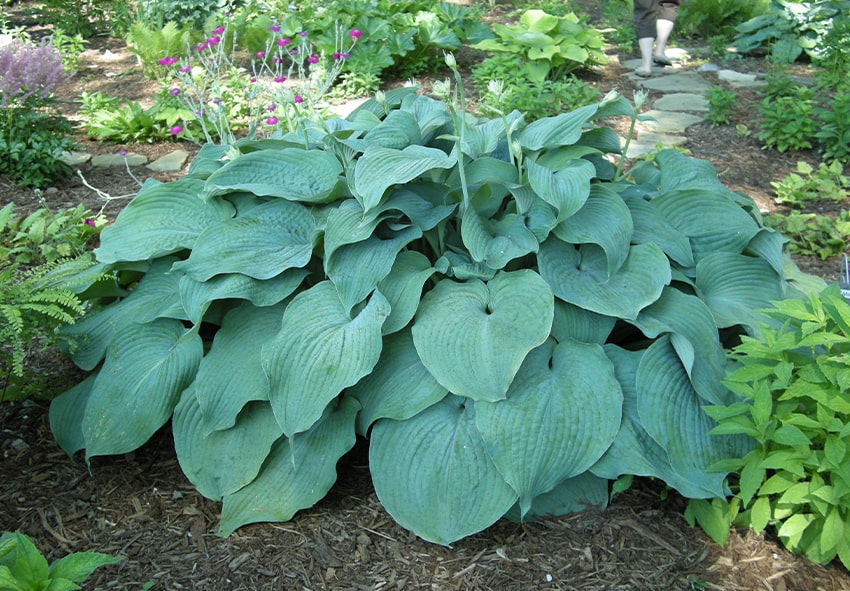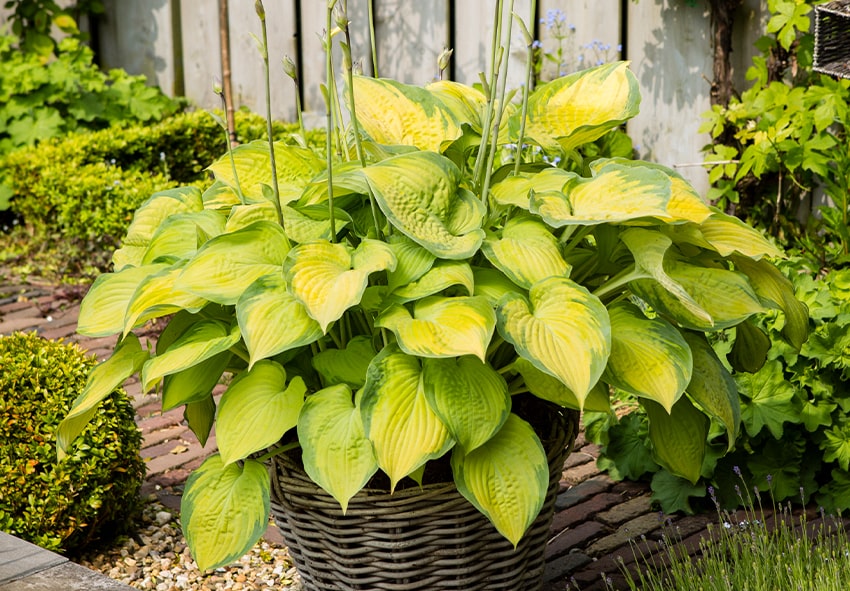“Beauty of the garden,” “queen of the shadow” — there are a lot of nicknames gardeners give to this plant. Many of them save the best place on their site for this noble plant, frame flower beds with it, and use it in landscape design. Unfortunately, the seedling of this luxurious flower is relatively expensive. However, there is a way around this — growing hosta from seeds.
What do hosta seeds look like?

To not buy the wrong planting material, you should know how it looks. Hosta plant seeds resemble a small, dark brown raisin with a diameter of no more than 1 cm. They are located in the place of faded buds in yellow dry capsules.
To collect planting material for further cultivation, you need to wait until it matures. This happens in the second week after the pollination of the flower. More precisely, this usually is at the end of August or the first week of September. It is crucial not to miss the moment when the hosta flower seeds capsules turn a rich brown colour, dry out, and open. After this, you need to collect the seeds in a maximum of 5 days.
Germinating hosta seeds properly
Before sowing hosta plants seeds, you need to prepare them properly: Dry them and leave them for storage until you start planting and growing. To do this, dry the collected material at high temperatures (300°C) for about 10 minutes, then place it in a refrigerator for 30 days.
It is best to store hosta seeds in small bags or paper towels. They should not be stored in direct sunlight or temperatures below 10°C. You can use the prepared material any time within 2 years.
How to plant hosta seeds
For hosta seeds propagation, you first need to sow them. To do this, you will have to take into account the appropriate planting time, choose a container of the right size, prepare the soil, and stimulate the seeds.
When to plant hosta seeds
When to sow hosta seeds UK? There is no exact period in which to plant hosta seeds. For the seedlings to be strong enough to transplant into the open ground until the weather is consistently warm, it is recommended to carry out this process in early January. Sow the seeds as follows:
- For hosta seeds growing, first, you need to fill the container properly. The bottom layer will be for drainage; it needs to have small pebbles in it.
- Next, pour a mixture of soil. A small part of it must be left to complete the work.
- For planting hosta seeds, the soil should be slightly moistened. They can be sown quite densely, as the plants will subsequently be separated.
- Lightly sprinkle the spread-out seeds with the remaining soil (a layer of no more than 1 cm). If the top layer is too thick, seedlings will have to wait longer, or they will not appear at all.
- From above, cover the container with glass or a transparent film. This is necessary to protect the seedlings, maintain the temperature, and retain moisture. The film can be completely removed after the first seedlings appear.
The plant germinates 4 weeks after sowing.
Avoid watering for the first week. Subsequently, it must be carried out as carefully as possible and as the soil dries up.
Potting up hosta seedlings

As soon as the first leaves appear, the plants should be prepared for potting. When planting, it is a good idea to choose pots that make it as easy as possible to transplant into the ground subsequently. Carefully remove each plant along with a clod of soil and lower it into a prepared pot. From above, you can add soil and lightly press it. If the seedlings are quite rare, leave them as they are. If the air outside is warm enough, take the seedlings out for a short time to the garden or balcony. The crucial thing is that there are no strong drafts.
Recommendations to hedge
Before growing a hosta from seeds at home, you need to think about where it will be planted in the future. It is crucial to choose a site that is comfortable for the hosta to grow and develop in. This plant is not too temperamental. Nevertheless, certain nuances must be taken into account:
- Hostas love the half shade and do not survive drafts;
- The brighter the hosta leaves, the more light that variety requires;
- Blue varieties need only a few hours of sunlight per day;
- Variegated hostas prefer to grow in groups and love midday shade and bright mornings and evenings.
Hostas germinated from seeds prefer a slightly acidic or neutral soil, which should be moist and permeable to water and air. Pure sand or loam is not suitable. You can prepare your soil in autumn. It is necessary to take organic fertilizers that contribute to the optimal soil acidity. Distribute them evenly over the entire landing area at a depth of about 10 cm. By spring of the next year, the site will be acceptable for your plant.
Outdoor planting
Closer to July, you can start preparing a permanent site for perrenials. Even a shady area is suitable for hostas — this is their main advantage. Direct planting in open ground begins with the formation of holes at a distance of about 50-60 cm from each other. If you are planting varieties capable of reaching impressive sizes, leave gaps of up to 1 meter. Before transferring seedlings from the pot, they must first be well watered. Then, along with a piece of soil, remove the seedlings from their usual container and immerse them in dug holes so that the top layer of soil is several centimetres below ground level. It is crucial not to damage the roots. If they are wide enough, then they should be carefully straightened. Next, generously cover the hole with soil, pour several litres of water into it, and supplement it with sawdust from above.

Hosta seedling care
Caring for a planted seedling is quite simple. It does not need special feeding. However, in the autumn, it is possible to fertilize the soil with humus, compost, or granular substances. At first, root and foliar fertilizers are required once every two weeks. If the flower was planted at the end of spring, then this kind of top-dressing should be carried out before the beginning of July. Thus, the plant will receive an optimal stimulus for growth and, at the same time, be able to prepare for wintering fully.
Regular watering is important, as the ground around the hosta should almost always be wet, especially for a young plant. It is advisable to water hostas in the morning and not let the water run in a strong stream over the leaves. Gently direct it with a moderate stream under the root so that the soil is wet and, at the same time, does not condense. In the early months, it is recommended to loosen the soil and remove small weeds.
Gardeners who want to get a beautiful bush should remove the first floriferous shoots so that the hostas do not fall apart after flowering. Later, after 3 years, the bush will need separation, which occurs by separating the cuttings from the root.
Read also Growing Dahlias in Pots.
Frequently Asked Questions (FAQs) about Planting Hosta Seeds
1. Can I Grow Hostas from Seed?
Yes, you can definitely grow hostas from seed! Hostas are typically propagated through division, but they can also be grown from seeds. However, it’s important to note that growing hostas from seed can be a slower and more challenging process compared to division. Hosta seeds require a period of cold stratification to break dormancy, which can take a few weeks or even several months. Once they germinate, hosta seedlings need consistent moisture, well-draining soil, and adequate light to thrive. Keep in mind that hosta seeds may not produce plants that are identical to their parent, so expect some variation in leaf color and shape.
2. When Is the Best Time to Plant Hosta Seeds?
The ideal time to plant hosta seeds is in late winter or early spring, typically from late February to April, depending on your climate zone. This timing allows for the necessary cold stratification, as hosta seeds need exposure to cold temperatures for a period to break dormancy. You can sow the seeds indoors in containers or trays and then transplant the seedlings into your garden or larger pots when they are big enough. Keep in mind that it may take a couple of years for hosta seedlings to reach a size where they resemble mature hosta plants.
3. How Long Does It Take for Dutch Hosta Seeds to Germinate?
Hosta seeds can take anywhere from a few weeks to several months to germinate. The time it takes for germination depends on various factors, including the specific hosta variety, temperature, and the effectiveness of the cold stratification process. Some hosta seeds may germinate within a few weeks after being exposed to cold stratification and warmth, while others may take several months. Be patient and keep the soil consistently moist during this period. Once they sprout, continue to care for the seedlings with proper light and moisture.
4. Are Hosta Seeds Available for Purchase in Your Online Store?
Yes, we offer a selection of hosta seeds for purchase in our online store. Our store provides a variety of hosta seed options, including different colors, sizes, and leaf patterns. We source our seeds from reputable suppliers to ensure quality, and they are often packaged with planting instructions. If you’re interested in growing hostas from seed, browse our online store to explore the available options and find the perfect hosta seeds for your garden.
5. Can I Expect the Same Variability in Seed-Grown Hostas as Division-Grown Hostas?
Seed-grown hostas can exhibit some variability in terms of leaf color, size, and shape, similar to division-grown hostas. This is because hosta seeds are produced through pollination and may result in genetic variation. While you won’t get identical replicas of the parent plant, this variability can be exciting for gardeners looking to experiment with different hosta characteristics. If you desire more consistency in your hosta garden, it’s recommended to propagate hostas through division, as this method ensures that you get clones of the parent plant. Seed-grown hostas offer diversity and a fun element of surprise for those who enjoy the uniqueness of each plant.
Published: 05.03.2022

Comments: 1
22.03.2023 at 11:08
Thanks for the detailed information. Im a novice and this has been very helpful.